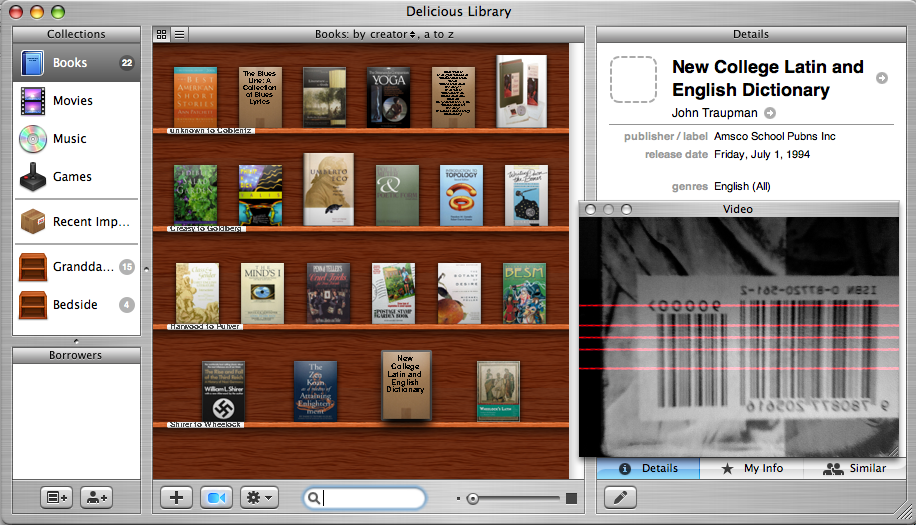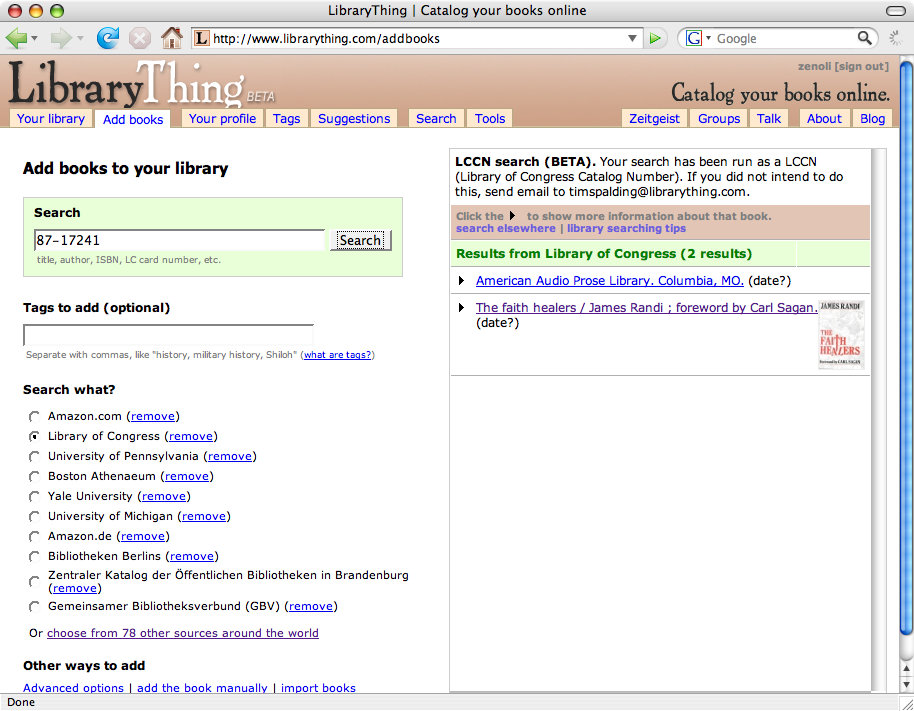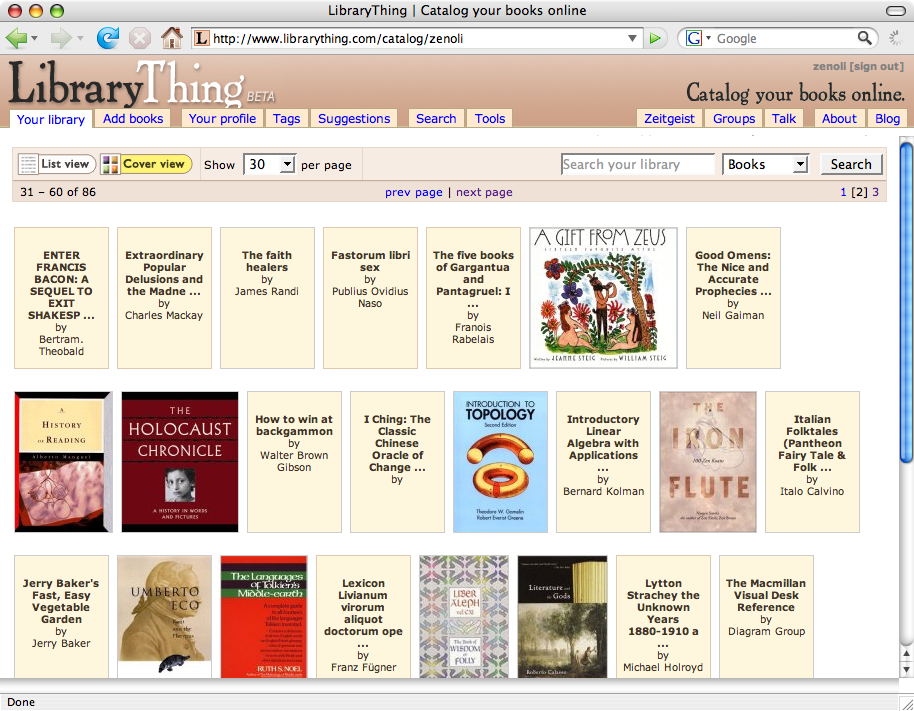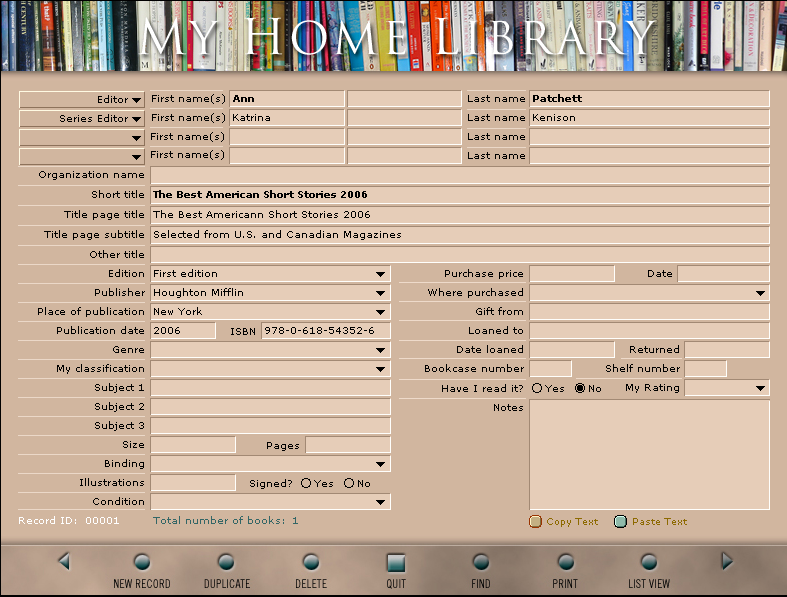[Updated 23 July 2007: Minor typographical corrections, added a mention of LibraryThing’s CueCat offer, added a screenshot of the NYPL HLS.]
In which we examine LibraryThing, Delicious Library, and the New York Public Library Home Library System.
Where is human nature so weak as in a bookstore?
—Henry Ward Beecher, 1855
The books continue to accumulate, despite a valiant effort at asceticism . . . I let my guard down for a moment, and there are another couple book-feet sitting on the coffee table. One must face up to the fact that a personal library is not a self-organizing phenomenon.
Well, perhaps that’s not strictly true, but the order that emerges tends to be less than helpful: if I’ve read it recently, it’s lying on some surface (perhaps, I’m sorry to say, on the floor by the bed); if I haven’t read it recently, it’s on a bookshelf somewhere; and if I want to read it, it’s in a box in the attic. It is that last category (and the fear that one of those boxes might actually be mouldering in the basement) that causes the most pain. Getting the books in order is moving up the priority list.
Like any good book-obsessed geek, I’ve been meaning to pick up a bar-code scanner to help automate the tedium of data-entry. Recently, I’ve read about video barcode readers that can pluck and decode the barcodes from a camera. Thus, like any good Linux geek (and being extremely cheap), I started wondering if there were any free or open source software packages I could appropriate. Today, I did some digging.
The best I could dredge up along those lines is /barCode, which looks a bit raw but could perhaps be coaxed to work on my XV6700. During my search, though, I happened across something not free but still quite impressive: Delicious Library.
Delicious Library
Delicious Library is a Mac OS X app with supremely spiffy, live, video barcode recognition. Despite my Linux ways, I’ve been playing around with a MacBook Pro that has an integrated camera, so I figured I’d give it a try.

I sat down next to one of my bookshelves and started scanning. It took a moment to find the right distance and angle, but very quickly there was a beep, and almost instantly DL had sucked down the information from Amazon, displayed a small image of the cover, and read out the title in a synthesized voice. Slick! I proceeded through the first dozen books on the top shelf: of these, three were unrecognized.
DL appears to be performing its primary lookups through the UPC code; as near as I can tell, you have to manually enter the ISBN to run a search if the UPC isn’t found. It took a bit of frustrated poking to figure out how to make that happen . . . for example, there’s no ISBN field visible on the book information entry panel, which was quite vexing. For pre-ISBN books, you appear to be completely out-of-luck. I wanted to just enter the title and have the program give me a list of possible matches from which to choose, but this doesn’t appear to be an option.
Once the books are scanned and recognized, they can be organized by creating shelves and dragging and dropping, but this is about the limit of the interactivity. Books can be rated and notes entered, but there’s no tagging that I could find. The Similar function can be used to list related books on Amazon, but any wishlist management would have to be delegated there; there’s no such capacity in DL.
One theoretically interesting feature is voice search: you can speak the name of any title in your library, and DL will pop it up. I didn’t find this particularly helpful or successful. You need to speak the full title (including subtitle, if any) at just the right speed. Some titles, try as I might, simply would not be recognized. Being able to speak a word or two and get a list of candidates would have been much more useful: if I know exactly what I’m looking for, I hardly need to search for it.
Delicious Library is $40, and the demo will let you scan up to twenty-five books before making you pay. If you’ve got a Mac, it’s definitely worth some experimentation. It allows full import/export, so it might be possible to use the free version to scan the easy parts of your library in 200-book chunks, to be imported into another application.
LibraryThing
Delicious Library’s scanning was quite slick, but I could already feel the limitations chafing a bit. I’d glanced at LibraryThing several times over the past few months, but had never felt a serious urge to try it out. Letting the world know what books I’ve purchased doesn’t seem to be particularly necessary. Today, though, the bit was in my teeth, and I plunged right in.
LibraryThing is completely web-based, with a strong social component (finding other people who own the same books, and so on). Sign-up is instant . . . to log on is to create an account, no email address required. As previously mentioned, I don’t yet own a barcode scanner, so ISBN entry was by hand. Typing ten digits by hand isn’t too hard, and very quickly the first book popped up. Once you enter a title, you get a list of matches; for any book for which I had an ISBN, there was only one option, which required clicking on a link.
The data entry flow was pretty smooth. I could leave the mouse hovering over the spot where the link would appear, and after each entry the cursor remained in the search box: type ISBN, hit return, click repeat. Some keyboard shortcuts are definitely indicated, though.

The particular bookshelf I selected (after the top shelf) included a few challenges, including relatively recent volumes, books from the fifties without ISBNs, and texts going back to 1871 (including several in Latin that were published in Germany).
Everything with an ISBN was recognized immediately and smoothly. LibraryThing allows searches by Library of Congress number (insanely cool) which handled the several mid-twentieth century books with ease (though I had to switch the search corpus from Amazon to the LoC, and LoC searches sometimes turned up several hits).
One exceptional feature is the ability to search the catalogs of dozens of different libraries, as well as international Amazon listings. Amazingly, I was able to scrape up information from around two-thirds of the nineteenth-century, Leipzig-published books from German libraries, though I had to correct an occasional date field. You can only search one library at a time, though, so I had to perform up to eight searches in some cases before I found a hit.

Like Delicious Library, LibraryThing offers a visual display of the covers in your collection (I assume it’s possible to upload covers for volumes that lack them, though I’ve yet to determine how.) The navigation is, unsurprisingly, not as convenient as the desktop application, and lacks the spiffy shelf graphics. There’s no drag and drop, either . . . this is a site that could use a good shot of AJAX.
More significantly, LibraryThing has no concept of shelving. It provides tagging, so I suppose one could approximate a filing system by tagging with shelf names or numbers. I found the tagging interface a bit awkward, though, and nowhere near as smooth as the data entry. Trying to tag multiple books at once involved lots of laborious clicking on tiny checkboxes, and it was very hard to manipulate tags directly. Also, I would have like to have the option of appropriating tags that other have used, rather than having to type everything myself from scratch. Perhaps theses features are there, but I’m not finding them.
I’ve not played much with the social aspects of LibraryThing, and the eclectic set of books I entered has not revealed my bibliodoppelgänger. I’ll be poking around some more over the next few days.
LibraryThing is ludicrously affordable: you can keep 200 books in your catalog for free; after that, it’s $10 for a year or $25 for a lifetime membership. They are also offering :CueCat barcode readers for $15, so $40 will get you either the current edition of Delicious Library, or LibraryThing lifetime membership plus a barcode reader.
In a few hours of playing around I scanned 86 books, and I’m deeply tempted to keep going. One of my key requirements, though, is keeping track of which book is in which box, and I’m not sure if the blunt instrument of tagging will be effective.
The New York Public Library Home Library System
I’m going to mention one more product, sold as Your Home Library: The Complete System for Organizing, Locating, Referencing, and Maintaining Your Book Collection This is a kit with personal library software, a binder with parchment-like paper for printing a permanent record, and a 128-page book on home library organization. Knowing my vices (and, I might point out, M——‘s vices), my brothers gave us a copy for Christmas a few years back. I started a bit of cataloguing, but the sheer volume of the task militated against entering the entire collection.

The included book is quite a useful little guide on categorization organization strategies and contains some painfully pointed advice on culling one’s collection. The software is written for Windows and Mac (and could probably be coaxed to run under Wine on Linux). Unfortunately, the package is from 2002 or so and written using FileMaker 6.0, and every bit of data entry is manual. It also takes over your entire screen, which I’d have to categorize as “not playing nicely with others”. (It does have explicit support for recording exactly where you’ve filed each book in your collection, which would be nice to see in LibraryThing). Entering a single book takes around five minutes, whereas you can whip through six to ten non-problematic books in a minute with either Delicious or LibraryThing.
You can pick up a used copy for five bucks or so, but in 2007 I’d have to say that Internet lookup of catalog information is a sine qua non.
Summary
Delicious Library is slick as hell but with some frustrating limitations. LibraryThing is extremely powerful with unparalleled lookup capabilities; some user interface work and the addition of field for shelving information would suck me in totally. The New York Time Library System has useful information in the included book, but its software is strictly outmoded.
There are several other sites and software packages out there than can fill the personal library management niche, but a quick gloss of the reviews suggest that they remain behind LT for the moment. You can view the LibraryThing test catalog I created, should you so desire. If I decide to use LT as my primary library catalog, I’d have to think long and hard before I made my listing public. Sometimes, one just wants to be alone with one’s books.
 Next, I was presented with a list of five matches. I was initially dismayed that Gulim Bold did not appear on the list, but upon closer examination, the first suggestion, Prima Sans Bold, is a dead ringer. I’d have to guess that Gulim is a not-very-subtle clone; I’d be very happy with such a close match if I needed to match Gulim for a project.
Next, I was presented with a list of five matches. I was initially dismayed that Gulim Bold did not appear on the list, but upon closer examination, the first suggestion, Prima Sans Bold, is a dead ringer. I’d have to guess that Gulim is a not-very-subtle clone; I’d be very happy with such a close match if I needed to match Gulim for a project.



